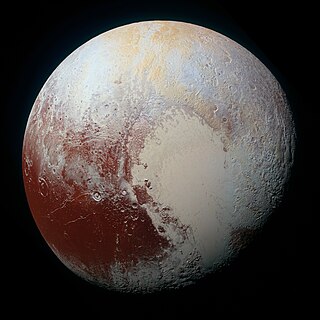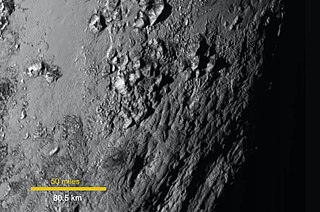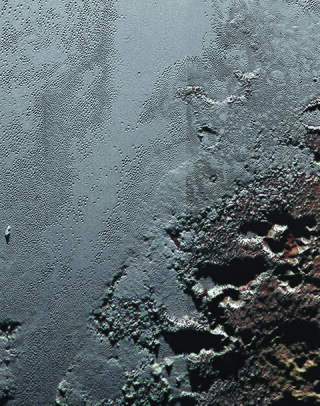Related Research Articles

Pavonis Mons is a large shield volcano located in the Tharsis region of the planet Mars. It is the middle member of a chain of three volcanic mountains that straddle the Martian equator between longitudes 235°E and 259°E. The volcano was discovered by the Mariner 9 spacecraft in 1971, and was originally called Middle Spot. Its name formally became Pavonis Mons in 1973. The equatorial location of its peak and its height make it the ideal terminus for a space elevator, and it has often been proposed as a space elevator location, especially in science fiction. It is also an ideal location for a Sky Ramp.

Ascraeus Mons is a large shield volcano located in the Tharsis region of the planet Mars. It is the northernmost and tallest of three shield volcanoes collectively known as the Tharsis Montes.

The Tharsis Montes are three large shield volcanoes in the Tharsis region of the planet Mars. From north to south, the volcanoes are Ascraeus Mons, Pavonis Mons and Arsia Mons. Mons is the Latin word for mountain; it is a descriptor term used in astrogeology for mountainous features in the Solar System.

A cryovolcano is a type of volcano that erupts gases and volatile material such as liquid water, ammonia, and hydrocarbons. The erupted material is collectively referred to as cryolava; it originates from a reservoir of subsurface cryomagma. Cryovolcanic eruptions can take many forms, such as fissure and curtain eruptions, effusive cryolava flows, and large-scale resurfacing, and can vary greatly in output volumes. Immediately after an eruption, cryolava quickly freezes, constructing geological features and altering the surface.

The geology of Pluto consists of the characteristics of the surface, crust, and interior of Pluto. Because of Pluto's distance from Earth, in-depth study from Earth is difficult. Many details about Pluto remained unknown until 14 July 2015, when New Horizons flew through the Pluto system and began transmitting data back to Earth. When it did, Pluto was found to have remarkable geologic diversity, with New Horizons team member Jeff Moore saying that it "is every bit as complex as that of Mars". The final New Horizons Pluto data transmission was received on 25 October 2016. In June 2020, astronomers reported evidence that Pluto may have had a subsurface ocean, and consequently may have been habitable, when it was first formed.

Tharsis Tholus is an intermediate-sized shield volcano located in the eastern Tharsis region of the planet Mars. The volcano was discovered by the Mariner 9 spacecraft in 1972 and originally given the informal name Volcano 7. In 1973, the International Astronomical Union (IAU) officially designated it Tharsis Tholus. In planetary geology, tholus is the term for a small domical mountain, usually a volcano.

Ahuna Mons is the largest mountain on the dwarf planet and asteroid Ceres. It protrudes above the cratered terrain, is not an impact feature, and is the only mountain of its kind on Ceres. Bright streaks run top to bottom on its slopes which are thought to be salt, similar to the better known Cererian bright spots, and likely resulted from cryovolcanic activity from Ceres's interior. It is named after the traditional post-harvest festival Ahuna of the Sümi Naga people of India. In July 2018, NASA released a comparison of physical features, including Ahuna Mons, found on Ceres with similar ones present on Earth.

Tombaugh Regio, sometimes nicknamed "Pluto's heart" after its shape, is the largest bright surface feature of the dwarf planet Pluto. It lies just north of Pluto's equator, to the northeast of Belton Regio and to the northwest of Safronov Regio, which are both dark features. Its western lobe, a 1,000 km (620 mi)-wide plain of nitrogen and other ices lying within a basin, is named Sputnik Planitia. The eastern lobe consists of high-albedo uplands thought to be coated by nitrogen transported through the atmosphere from Sputnik Planitia, and then deposited as ice. Some of this nitrogen ice then returns to Sputnik Planitia via glacial flow. The region is named after Clyde Tombaugh, the discoverer of Pluto.

Belton Regio is a prominent surface feature of the dwarf planet Pluto. It is an elongated dark region along Pluto's equator, 2,990 km (1,860 mi) long and one of the darkest features on its surface.

The geography of Pluto refers to the study and mapping of physical features across the dwarf planet Pluto. On 14 July 2015, the New Horizons spacecraft became the first spacecraft to fly by Pluto. During its brief flyby, New Horizons made detailed geographical measurements and observations of Pluto and its moons.

The Tenzing Montes are a range of icy mountains on Pluto, bordering the southwest region of Sputnik Planitia and the nearby Hillary Montes and Wright Mons. With peaks reaching 6.2 km in height, they are the highest mountain range on Pluto, and also the steepest, with a mean slope of 19.2 degrees.

Sputnik Planitia is a large, partially glaciated basin on Pluto. About 1,400 by 1,200 km in size, Sputnik Planitia is partially submerged in large, bright glaciers of nitrogen ice. Named after Earth's first artificial satellite, Sputnik 1, it constitutes the western lobe of the heart-shaped Tombaugh Regio. Sputnik Planitia lies mostly in the northern hemisphere, but extends across the equator. Much of it has a surface of irregular polygons separated by troughs, interpreted as convection cells in the relatively soft nitrogen ice. The polygons average about 33 km (21 mi) across. In some cases troughs are populated by blocky mountains or hills, or contain darker material. There appear to be windstreaks on the surface with evidence of sublimation. The dark streaks are a few kilometers long and all aligned in the same direction. The planitia also contains pits apparently formed by sublimation. No craters were detectable by New Horizons, implying a surface less than 10 million years old. Modeling sublimation pit formation yields a surface age estimate of 180000+90000
−40000 years. Near the northwest margin is a field of transverse dunes, spaced about 0.4 to 1 km apart, that are thought to be composed of 200-300 μm diameter particles of methane ice derived from the nearby Al-Idrisi Montes.

The Hillary Montes or are a mountain range that reach 3.5 km above the surface of the dwarf planet Pluto. They are located northwest of Tenzing Montes in the southwest border area of Sputnik Planitia in the south of Tombaugh Regio. The Hillary Montes were first viewed by the New Horizons spacecraft on 14 July 2015, and announced by NASA on 24 July 2015.

Wright Mons is a large, roughly circular mountain and likely cryovolcano on the dwarf planet Pluto. Discovered by the New Horizons spacecraft in 2015, it is located southwest of Sputnik Planitia within Hyecho Palus, adjacent to the Tenzing Montes and Belton Regio. A relatively young geological feature, Wright Mons has attracted attention as one of the most apparent examples of recent geological activity on Pluto and borders numerous other similarly young features. Numerous semi-regular hills surround and partially construct the flanks of Wright Mons. Their nature remains unexplained, with few, if any, direct analogs elsewhere in the Solar System.
Baret Montes is a chain of mountains on the surface of the dwarf planet Pluto. It is located near the western border of Sputnik Planitia in Tombaugh Regio. These mountains were first viewed by the New Horizons spacecraft. It features large ridges that are formed by the compression of methane and water ice.

Safronov Regio is the westernmost of the "Brass Knuckles", a series of equatorial dark regions on Pluto.

Leviathan Patera is a major cryovolcanic caldera on Neptune's largest moon Triton. Discovered by the Voyager 2 spacecraft in 1989, Leviathan Patera is located in Monad Regio and within Cipango Planum's western regions. Leviathan Patera is approximately 80 kilometers in diameter and may be the center of one of the largest cryovolcanic or volcanic edifices in the Solar System.
Liberalia Mons is a mountain on the surface of the dwarf-planet Ceres.
References
- ↑ "Piccard Mons". Gazetteer of Planetary Nomenclature. USGS Astrogeology Research Program. (Center Latitude: -35.26°, Center Longitude: 176.79°; Planetocentric, +East)
- ↑ "Piccard Mons Information". planetarynames.wr.usgs.gov.
- ↑ "Map of Pluto". planetarynames.wr.usgs.gov.
- ↑ "Piccard Mons Information". planetarynames.wr.usgs.gov.
- ↑ Luntz, Stephen (29 March 2022). "Discovery of Piccard Mons". www.iflscience.com.
- ↑ Luntz, Stephen (29 March 2022). "Piccard Mons Taller than the Andes". www.iflscience.com.
- ↑ Singer, Kelsi; White, Oliver; Schmitt, Bernard; Rader, Erika; Protopapa, Silvia; Grundy, William; Cruikshank, Dale; Bertrand, Tanguy; Schenk, Paul; McKinnan, William; Stern, S. Alan; Dhingra, Rajani; Runyon, Kirby; Beyer, Ross; Bray, Veronica; Ore, Cristina; Spencer, John; Moore, Jeffery; Nimmo, Francis; Keane, James; Young, Leslie; Olken, Catherine; Lauer, Tod; Weaver, Harold; Ennico-Smith, Kimberly (29 March 2022). "Large-scale cryovolcanic resurfacing on Pluto". Nature Communications. 13 (1): 1542. arXiv: 2207.06557 . Bibcode:2022NatCo..13.1542S. doi: 10.1038/s41467-022-29056-3 . PMC 8964750 . PMID 35351895.
- ↑ Moore, Jeffery (18 March 2016). "Geology of Pluto". Science. 351 (6279): 1284–1293. arXiv: 1604.05702 . doi:10.1126/science.aad7055. PMID 26989245.
- ↑ Fernandez, Elizabeth (12 May 2022). "How Volcanoes formed on Pluto". Big Think.
- ↑ Crane, Leah (29 March 2022). "Piccard Mons is an Effusive Cryovolcano". New Scientist.
- ↑ Fagents, Sarah; Lopes, Rosaly; Quick, Lynnae; Gregg, Tracy. "Cryovolcanism" (PDF). ntrs.nasa.gov.
- ↑ Hand, Eric (9 November 2015). "Ice volcanoes spotted on Pluto, suggest internal heat source". www.science.org.

